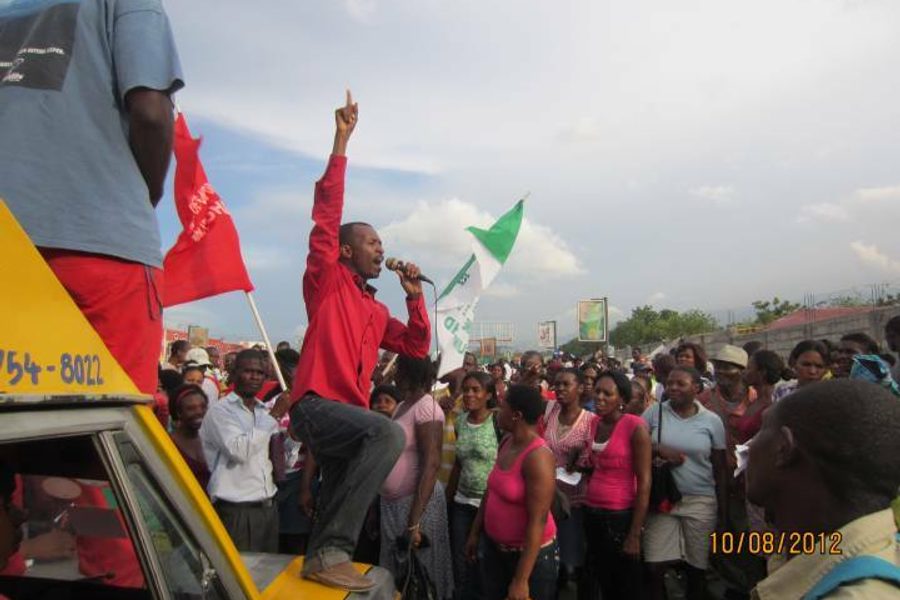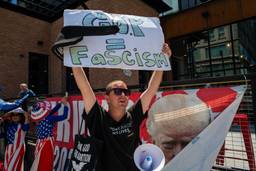
The small workers’ center in Port-au-Prince’s Delmas district was hot and the electricity had gone out, but about three dozen workers from the city’s apparel plants were willing to sit in the dark and the heat for nearly two hours after work one evening in early October to tell a group of U.S. activists about the struggle for better wages in Haiti.
“We have to pay for our transportation,” said “Jean” (not his real name), an employee at the Multiwear Assembly plant in the big industrial park near the airport. “We can’t do anything with our salary. We start work at 6 a.m. and finish at 5 p.m. The quota is huge. We don’t even have time to eat because we can’t meet the quota.”
Protests had broken out at the end of September and the beginning of October, the workers said, after factory owners stepped up production quotas to circumvent an increase in the minimum wage that went into effect on October 1. When employees at the Premium Apparel plant learned about the new quotas on September 29, they stood up from their machines and demanded to see the owner. At the nearby One World Apparel factory, workers staged a two-hour wildcat strike the morning of October 1.
The owners used selective firings and the threat of mass layoffs to get the workers back on the job. Exacerbated by Sandy shortages, food prices had jumped in Haiti over the preceding months, and the new school year was just starting, explained Premium employee “Roland” at the meeting. “With the situation in the country and with kids going back to school,” he said, the workers “realized they had to go back to work, under a lot of pressure.”
Caught between the rising cost of living and the fear of losing their jobs, the workers were looking for help from outside. “Today we’re glad that we have foreigners that are able to hear us, so that they can give us their support,” “Jean” told the visiting activists.
Low-wage “development”
The new minimum wage for piece work that the factory owners are fighting is 300 Haitian gourdes a day—about $7 for eight hours’ work.
An estimated 29,000 Haitians work in the country’s garment assembly. Most of the plants are clustered in Port-au-Prince near the airport. There is also a free trade zone in Ouanaminthe in northern Haiti, near the Dominican border, and a new industrial park was inaugurated on October 22 at the little town of Caracol, also in the north. The main product of Haiti’s garment factories is T-shirts for export to the North American market. The Port-au-Prince plants sell largely to the Montreal-based apparel firm Gildan Activewear Inc. and the North Carolina-based company Hanesbrands Inc. The new Caracol industrial park has already started shipping shirts to the U.S. retail giant Wal-Mart.
United Nations economic advisers and U.S. politicians like Bill and Hillary Clinton insist that the assembly sector is the key to economic development for Haiti. Successive Haitian governments have used this rationale to justify the tax exemptions and other benefits given to the assembly plants. Following the same logic, the U.S. Congress has lowered tariffs for garments imported from Haiti.
While it’s hard to see what these policies have done for Haiti’s development, they’ve been quite beneficial for North American apparel firms and retailers. In November the Toronto Globe and Mail reported that Gildan Activewear had “posted record fourth-quarter financial results.” An important factor was the use of “low-cost centres in other countries” after Gildan “close[d] its high-cost apparel manufacturing in Canada and the United States and shipped jobs to Central America and the Caribbean.”
Organizing in the plants
The workers’ center in Delmas is maintained by the leftist group Batay Ouvriye (“Workers’ Struggle”), which has the distinction of having organized the only union with a contract in the assembly sector, at the Ouanaminthe free trade zone. The group has been looking for similar victories in Port-au-Prince. In September 2011 a core of workers officially formed a union for the 16 apparel assembly plants in the capital. SOTA — the acronym for Sendika Ouvriye Tekstil ak Abiman, or the “Textile and Garment Workers Union” in english — has now established locals at six plants and maintains a presence at several others, according to Yannick Etienne, a lead organizer for Batay Ouvriye.
But union organizing isn’t easy in Haiti’s assembly sector. The fact that only one plant has a union with a contract gives some idea of the difficulties.
The workers coming to the meeting were visibly tired after a day at the factory, and many straggled in late because of overtime or varying work schedules. The majority of apparel workers are women, but there were only four or five at the meeting. Yannick Etienne, who moderated the discussion, shook her head when asked why so few women attended. “It’s the culture,” she said. Politics is still considered men’s work, and women are expected to be the poto mitan, the “central pillar” at home during the little time left over from the workday and the long trips to and from the plants.
If time is short, money is even more of a problem. According to a survey conducted by Haiti Grassroots Watch, work-related food and transportation costs currently use up half of a worker’s wages. For someone living so close to the edge, it’s difficult to risk even one day’s pay with a job action. A strike fund is virtually unimaginable.
Beyond all this there’s the likelihood that if the workers actually succeed in getting a contract and better pay, Gildan, Hanesbrand and Wal-Mart will simply move their orders to places with even lower wages — unless these corporations face a determined resistance from activists back in their home countries.
Reviving anti-sweatshop activism
The workers at the meeting understood this. They kept returning to the need for international solidarity.
Support from North American anti-sweatshop groups such as the Worker Rights Consortium was important in winning the collective bargaining contract in Ouanaminthe in 2006, and a certain level of solidarity work continues. When SOTA was formed last year, the owners of the Genesis and Multiwear plants promptly responded by firing six workers publicly associated with the union. A campaign by student groups and the Worker Rights Consortium (WRC) put pressure on Gildan and Hanesbrands, and five of the workers were reinstated by January 2012.
But activism around sweatshop issues has fallen off in the United States in recent years. Workers here have been preoccupied with their own problems since the start of the economic crisis in 2008, and the university students who were the main force in the anti-sweatshop movement have been hit by budget cutbacks and tuition hikes.
Still, the mood may be changing in North America. One important development is the renewed militancy of low-wage workers here, many of them immigrants from countries where apparel plants are concentrated.
The fire that killed 112 garment workers in Bangladesh on November 24 is also raising consciousness about the sweatshop issue — and about the culpability of the giant U.S. corporations like Wal-Mart that have their garments stitched in foreign firetraps. Significantly, low-wage retail workers organized by OUR Walmart are now “raising money and holding prayer services for the families affected by the fire in Bangladesh,” The Nation reports. There’s an obvious link to the struggle in Haiti: Wal-Mart is now outsourcing to the new Caracol park, built in part with $124 million in U.S. “earthquake relief” funds.
“The workers here in Haiti, the workers in the United States — there is only one thing we have to put in our minds,” said “Georges,” a former member of a coffee workers’ union in the north, near the meeting’s end. “This is one class that is confronting another class…[W]e must have an international working class that…must fight to crush that exploitative system.”
It was night by now, and the only light in the workers’ center came from occasional glimmers on the participants’ cell phones. “That might take some time,” added “Georges.”




